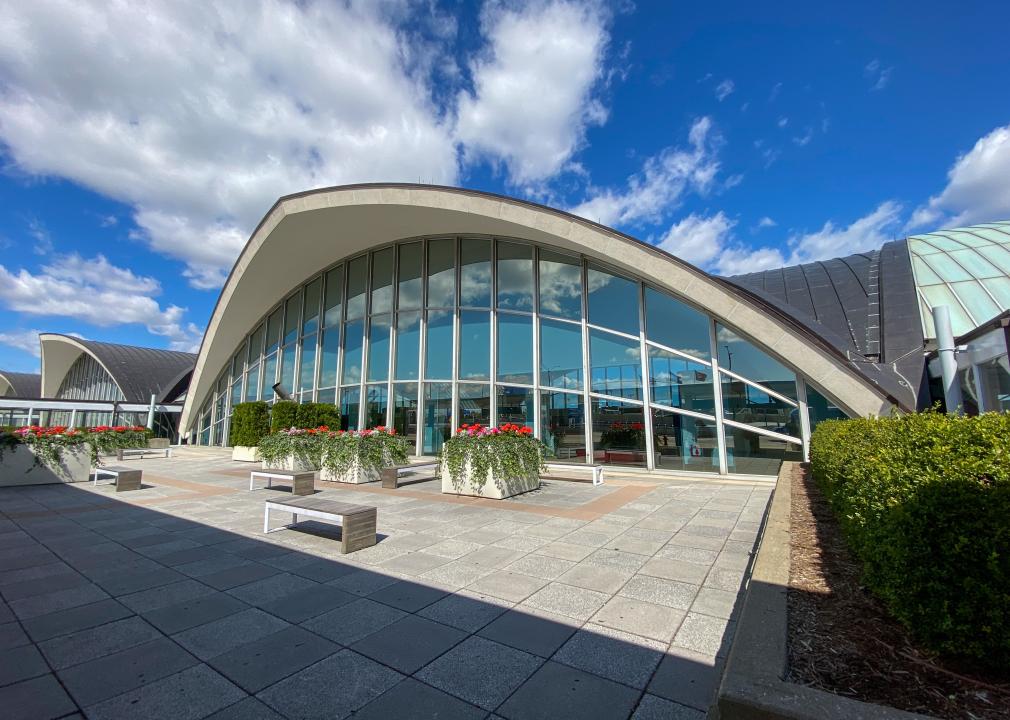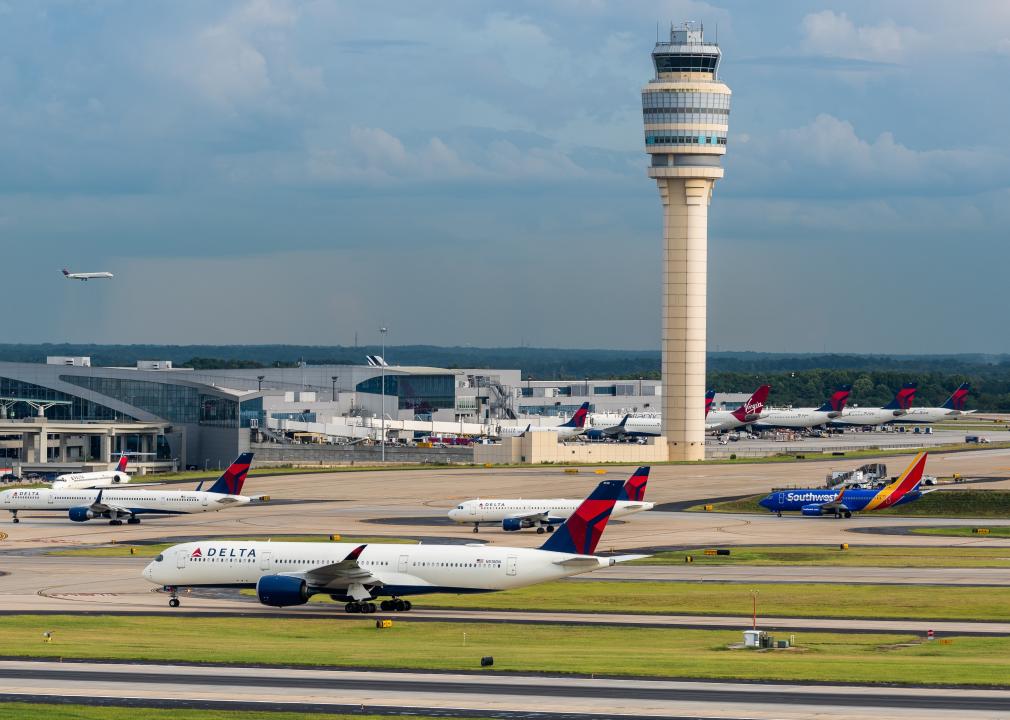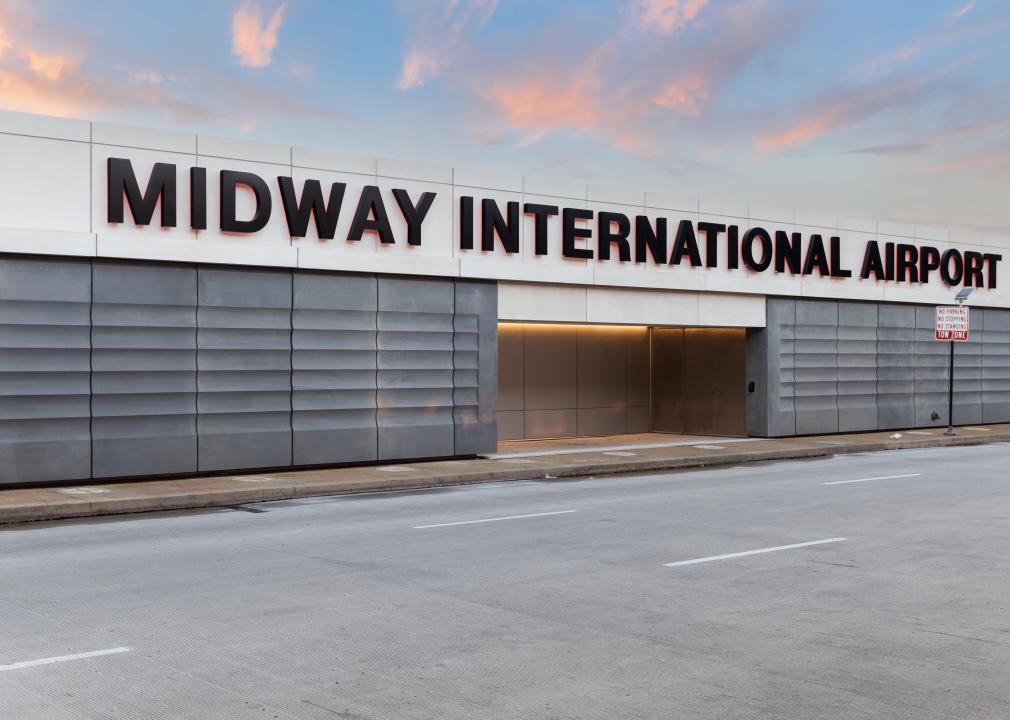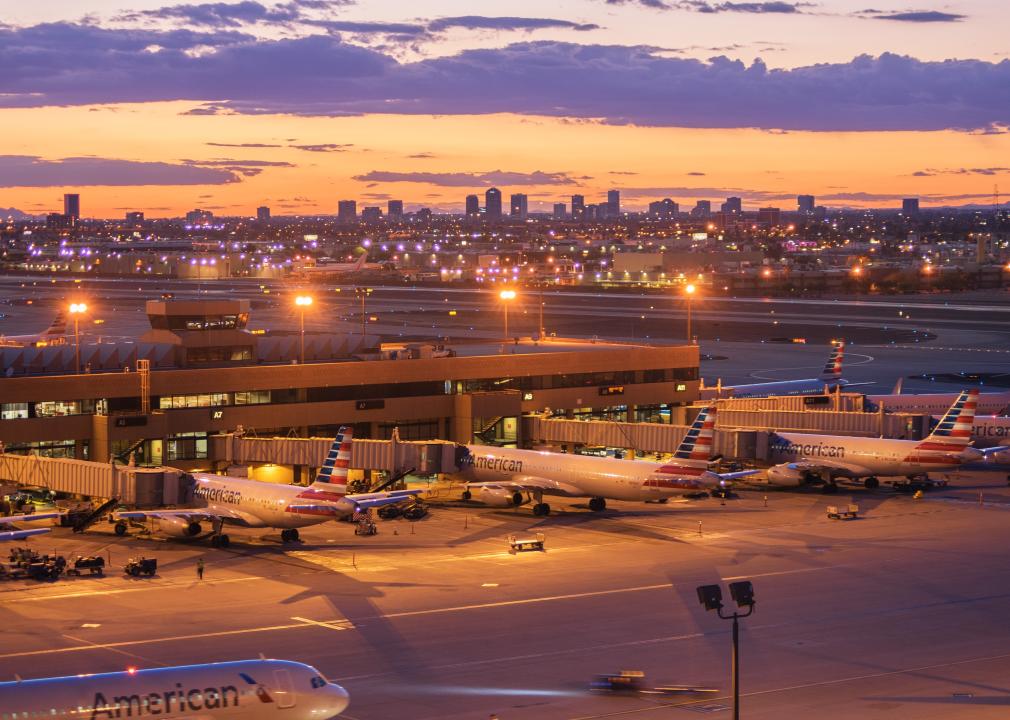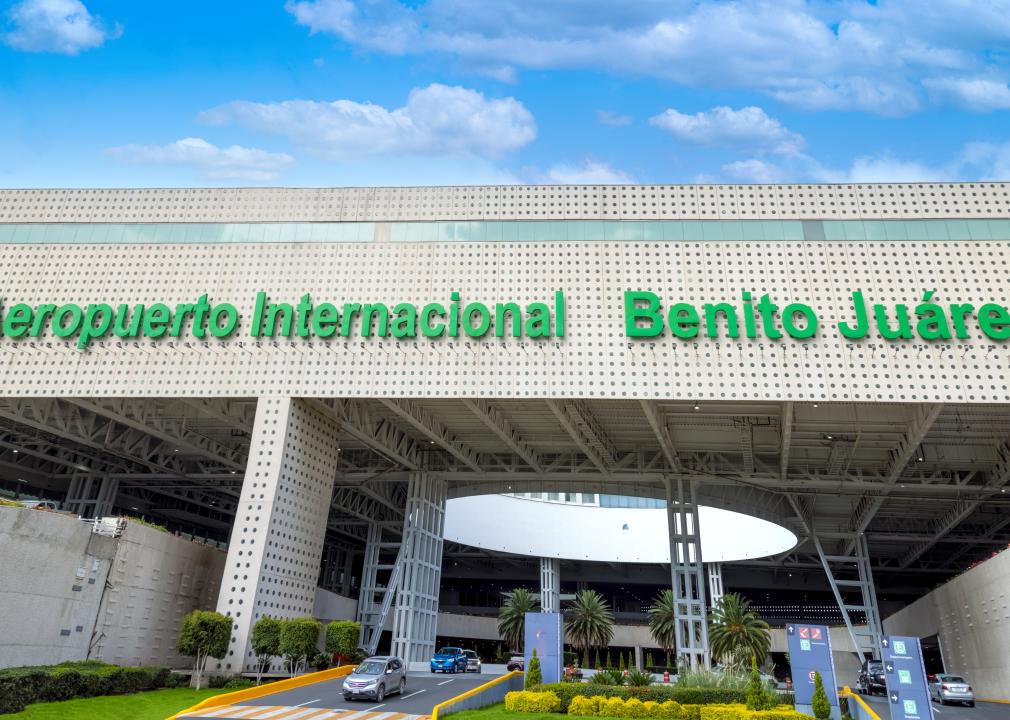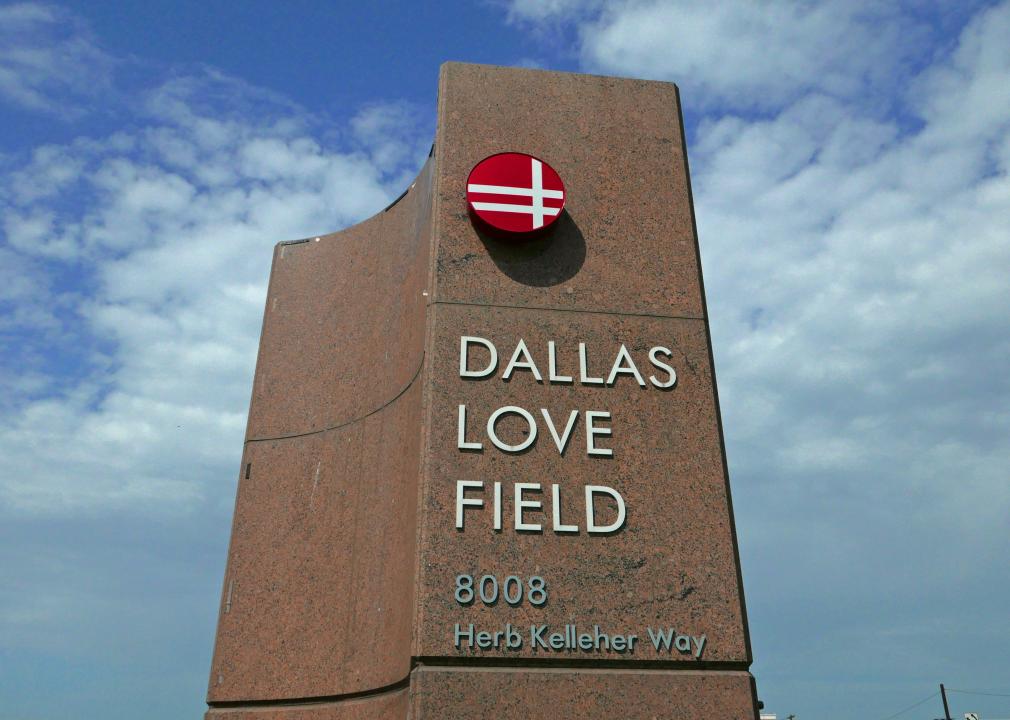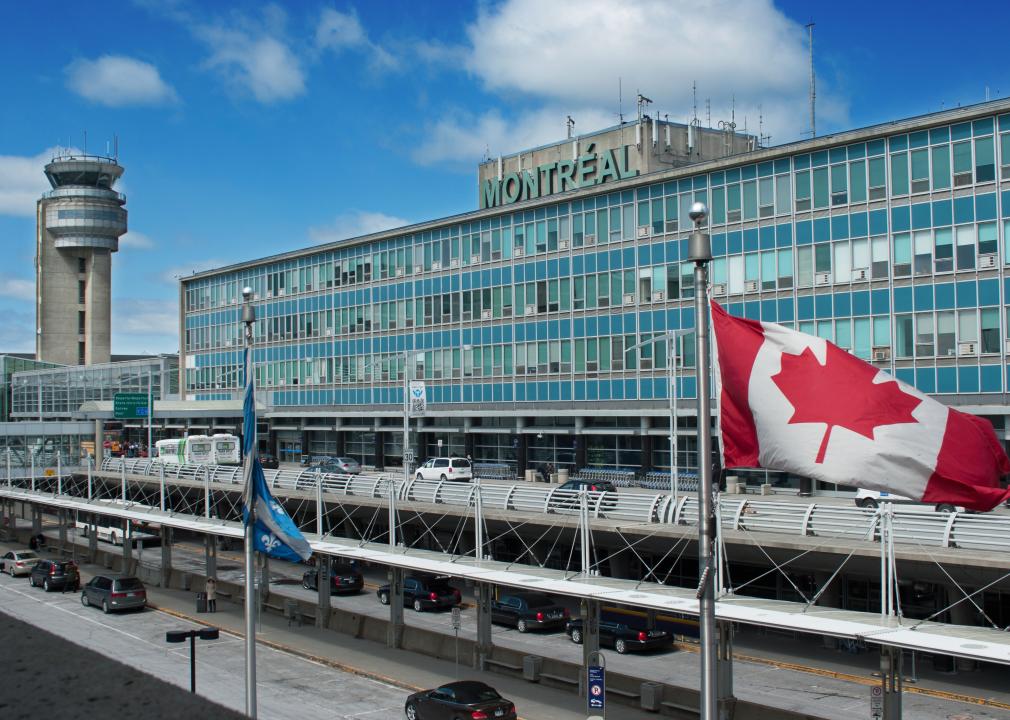The fascinating stories behind the names of 10 major airports in North America
Dima Moroz // Shutterstock
The fascinating stories behind the names of 10 major airports in North America
Empty airport terminal lounge with airplane on background.
Airports are a traveler’s gateway to new destinations, but the names of those airports also serve another purpose, as a window into that city’s history.
Many North American airports are named after prominent politicians. Former U.S. Presidents John F. Kennedy, Ronald Reagan, and George Bush all have large airports named after them, but sometimes other politicians will get their names on airports, too; the best example may be Washington D.C.’s airport that bears the name of former U.S. Secretary of State John Foster Dulles.
Other cities choose to honor their homegrown heroes with a renamed airport. Jazz musician Louis Armstrong carries the name of New Orleans’ airport, a city that also happens to be the birthplace of jazz music. In Louisville, Kentucky, the airport is named after boxing legend and civil rights activist Muhammad Ali, who grew up in the Derby City.
It’s easier to understand the etymology of airports that carry the names of timeless celebrities and political historymakers. But several airports around North America are named after people, and even events, that are less obvious.
Stacker researched the history of the names of North America’s busiest airports and uncovered 10 lesser-known stories behind them. Read on to find out who the Love in Dallas Love Field was or how Chicago’s O’Hare got its name.
![]()
Joni Hanebutt // Shutterstock
St. Louis Lambert International Airport
The exterior of St. Louis Lambert International Airport.
St. Louis’ airport is named after its founder, Albert Bond Lambert. Lambert became president of the company his father created, the Lambert Pharmaceutical Company, in 1896. The company was successful thanks to its top product, Listerine.
Lambert was also an aviation enthusiast, and in 1920, he bought land outside of the city to develop into an airfield. Confidence in aviation grew throughout the 1920s, and eventually, the city of St. Louis bought Lambert’s airfield to continue developing it into a nationally recognized airport.
juanpabloms // Shutterstock
Hartsfield–Jackson Atlanta International Airport
Hartsfield–Jackson Atlanta International Airport plane and tower.
The busiest airport in the world in 2023 bears a combination of two surnames belonging to Atlanta mayors who built the city’s airport into the behemoth it is today. In 1925, William B. Hartsfield founded Atlanta’s airport at the site of an abandoned racetrack that was once owned by the founder of the Coca-Cola company. In 1971, the Atlanta Municipal Airport was renamed William B. Hartsfield Airport after the former mayor. In 2003, the airport added Jackson to the airport’s name, after Atlanta’s first Black mayor, Maynard Jackson. During his tenure as mayor in the 1970s, Jackson helped redevelop the airport.
aquatarkus // Shutterstock
Toronto Pearson International Airport
Interior of Terminal 3 of Toronto Pearson International Airport.
Canada’s busiest airport was renamed to add Pearson to its name in 1984, paying homage to Nobel Peace Prize winner and Canada’s 14th prime minister, Lester B. Pearson. Before Pearson became prime minister, he was a key figure in creating the North Atlantic Treaty Organization, aka NATO, a military alliance among different countries but also a means of forging stronger political and economic ties globally.
Pearson also led Canada’s delegation to the United Nations. Pearson served as Canada’s prime minister from 1963 to 1968. His name was added to Toronto’s airport name posthumously, as Pearson died in 1972.
Coffee Mate // Shutterstock
Chicago O’Hare International Airport
Chicago O’Hare check-in counter and lines.
Chicago’s airport gets its name from a decorated U.S. Navy pilot who fought during World War II. The airport was originally named Orchard Field, but in 1949, Chicago’s city council renamed it after Edward “Butch” O’Hare.
O’Hare won a U.S. Medal of Honor, the first member of the Navy to do so during WWII, for single-handedly taking on nine Japanese bombers bearing down on an aircraft carrier. It led to him becoming an icon in the U.S. for supporting the war effort. He made appearances to help sell war bonds and to encourage others to enlist. O’Hare was killed later in the war in 1943, with some historians believing he died by friendly fire.
Joseph Hendrickson // Shutterstock
Chicago Midway International Airport
The exterior of the Midway International Airport sign during sunset.
Some airports aren’t named after people at all. That’s the case for Chicago’s smaller airport, Midway. It was named after the Battle of Midway, which occurred during World War II in June 1942. The battle took place between Japanese and U.S. forces near the Pacific island of Midway Atoll located roughly halfway between Tokyo and San Francisco.
The battle was a major turning point during the war, but today is a national wildlife refuge. Just as both Chicago airports share references to the Second World War, Midway also got its name changed the same year as O’Hare. In 1949, the Chicago Municipal Airport became Chicago Midway.
BCFC // Shutterstock
Phoenix Sky Harbor International Airport
Phoenix Sky Harbor International Airport airplanes at sunset.
Today, the airport in Phoenix ushers about 130,000 passengers flying domestically and internationally per day, but it started as an airport for much shorter flights. J. Parker Van Zandt created the company Scenic Airways and bought five farms just outside the city limits in order to fly people over the Grand Canyon on sightseeing tours. He named his airport Sky Harbor.
The airline company changed names and ownership during the Great Depression. The city of Phoenix bought the airport in 1935. But the company Van Zandt started, now named Grand Canyon Scenic Airlines, still gives scenic airplane tours today.
eskystudio // Shutterstock
Benito Juárez International Airport
Mexico City Benito Juarez International Airport Terminal exterior sign.
The airport for Mexico City, the largest city in North America, is named after Mexico’s 26th president: Benito Juárez came from Zapotec ancestry and was also Mexico’s first Indigenous president. Juárez is known as a reformer who brought in more progressive policies to benefit women and the middle class. He’s called the father of modern Mexico. Juárez died of a heart attack while in office in 1872. His name was added to Mexico City’s airport in 2006.
EQRoy // Shutterstock
Newark Liberty International Airport
Curbside of Newark Liberty International Airport.
One may assume that New Jersey’s airport is named after the Statue of Liberty, especially since Newark is the closest airport to the national monument by time. However, that answer would only be partially true. Newark renamed its airport in 2002, adding Liberty to the name to honor the heroes of 9/11, including the people aboard Flight 93, according to the local port authority and the city of Newark. Newark’s airport was the departure airport for Flight 93, the United Airlines flight that was hijacked during the 9/11 terrorist attacks.
Dorti // Shutterstock
Dallas Love Field Airport
Dallas Love Field tower sign outside.
Four years before Dallas would break ground on the grassland that would become Dallas Love Field Airport, the lieutenant whose name the airport bears would die during flight training. Lt. Moss Lee Love was from Virginia and died near San Diego in 1913.
There’s no record that the soldier ever stepped foot in Dallas, but several early airports were named after pilots who died while on duty. In 1917, Dallas Love Field Airport was created as a training base for soldiers serving in the Air Service during World War I.
DD Images // Shutterstock
Montréal-Pierre Elliott Trudeau International Airport
Exterior of Montreal International Airport building.
You may recognize the Trudeau surname found in Montréal’s airport. In 2004, the airport was named after former Canadian Prime Minister Pierre Elliott Trudeau, the father of current Prime Minister Justin Trudeau. There have been some movements to change the name of the airport, but local leaders have said they have no plans to change it. Pierre Trudeau served two terms as prime minister, from 1968 to 1979 and once more from 1980 to 1984.
Story editing by Carren Jao. Copy editing by Tim Bruns. Photo selection by Clarese Moller.

